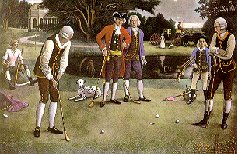TRADITIONAL
ENGRAVINGS
Traditional engravings are images of traditional subjects printed from copper or steel engraving plates. Engraving plates are quite sturdy. When treated with respect they can last indefinitely. Several publishers are still printing today from eighteenth, nineteenth and twentieth century plates that keep appealing to modern tastes.
The process
Old engravings were usually made after a painting, watercolor or drawing. In spite of the name, both engraving and etching techniques were used, often on the same plate. (With an etching the artist draws the lines in a coating on the plate. Acid eats away the metal where it is exposed. With an engraving the artist uses a burin to carve the lines directly into the plate.) In the nineteenth century the photogravure process was also used. This entails transferring an image to light-sensitive chemicals on a copper plate by use of photography, and letting acid etch the exposed surface.
A contemporary printer prepares and prints the engraved plates, still by hand. These prints are usually hand watercolored. Printing engravings is demanding work. Each engraving plate requires a different ink that is hand-mixed, from black or sepia pigment powder and linseed oil. The printer applies the ink to the warmed plate with a dabber. He uses canvas or muslin to work the ink into the fine lines and crevices, and simultaneously wipes the excess ink from the plate with a cloth. In the last stage before printing he removes any superfluous ink with the palm of his hand. Finally he applies whiting, a powdered chalk, to the borders of the plate with a cloth. When he has finished inking the plate, the printer places it on the bed of a hand operated printing press.
He then lays one sheet of pre-moistened, acid-free paper over the plate, and covers both with felt blankets. While he turns the big flywheel of the press, the paper passes through the heavy rollers. This exerts a carefully calculated downward pressure, which causes the ink to be transferred to the paper. Some printers go an extra step and print on a sheet of very thin India paper which is placed between the plate and the heavier paper. The force of the press causes the India paper to adhere to the second piece of paper. The India paper gives a very warm, rich tone. For every print the printer must apply ink to the plate again. This intricate and time consuming process leads to a beautiful intaglio print. Often the presses date from the same time as the plates themselves, and are over a century old.
After leaving the press, the printed paper is placed between absorbent blotters and under heavy weight to dry flat. The drying process can take three to four days. The publisher then turns the completely dry prints over to colorists. These professional artists give their full attention to the accuracy and application of the colors, using established patterns as guides. Often the colorists mix base materials, so that they achieve the purity and depth of color as in the old tradition. As each print is hand colored, they will of course vary in the coloring.
Framing
These valuable engravings are truly works of art in the purest sense. Just as care has been taken in producing the fine print, care should be taken with the framing. The owner of an engraving should consult a professional certified picture framer(CPF) for the best advice on how to preserve these treasures. If you need help finding a certified picture framer in your area call us at 1-504-835-8081 for assistance.
From Pretty Women to Fox Hunting
The subjects of traditional eighteenth and nineteenth century engravings are mostly taken from the lives of the middle and upper classes of that time. Hunting, famous racehorses, views and landscapes, pretty Victorian women and children, animals, and sporting scenes were very popular images. Paintings were reproduced as engravings, so that people who could not afford original works still could enjoy a beautiful piece of art in their homes. The artists of the original works demanded the utmost faithfulness from the engraver in rendering their paintings and discouraged 'artistic license' on the side of the engravers. The skills required from the engraver were enormous.
Sizes
Publishers chose paintings of all sizes to
reproduce as engravings. The engravings were not always done in the exact size
of the original. Often different publishers reproduced the same image in
various sizes. The smallest engravings in our collection are approximately
3"x 5". One of the largest that is still in print, a view of
Audubon's Engraver
Some famous names in art history can be found on engraving plates. Cousins, Thomas Landseer and Havell were engravers for Turner, Constable and Herring. Robert Havell is probably best remembered for his engraving of John James Audubon's original watercolors of the Birds of America. Some other famous artists names to look for are William Adolph Bougereau, Maud Earl, Albert Moore, Sir Lawrence Alma-Tadema, among hundreds of others. Look for your favorite artist's work.
Where to Buy Engravings
Thousands of plates have been preserved and are currently in print. The art gallery/picture framer is the place of choice to obtain your pictures. Ask your dealer to see what catalogs are available. If you are interested in a particular subject, talk to your dealer, and ask them to call Michael Alden Associates, LLC at 1-366-885-3440. You will be surprised at the possibilities.
(c) Cynthia Alden.
All antique prints are offered
unframed and subject to prior sale.
